Stadiums have evolved from mere venues for sports and events to immersive experiences where connectivity is as important as the action on the field. Fast connectivity in stadiums has become a necessity to meet the demands of tech-savvy fans who expect seamless access to social media, instant replays, mobile ticketing, and more. In this article, we'll explore the importance of fast connectivity in stadiums, the challenges involved, and the solutions that enhance fan experiences.
The Need for Fast Connectivity
Fast connectivity for Stadiums hubs where tens of thousands of spectators
gather to witness sporting events, concerts, and other performances. Within
these crowded spaces, the demand for fast and reliable connectivity is paramount
for several reasons:
Enhanced Fan Engagement: Fans want to share their experiences in real-time, whether through social media updates, live streaming, or interacting with stadium apps. Fast connectivity enables this instant engagement.
Mobile Ticketing and Transactions: Many stadiums have transitioned to mobile ticketing and cashless transactions. Fast connectivity ensures smooth entry, quick purchases, and efficient transactions throughout the venue.
Live Streaming and Replays: Fans expect access to high-quality live streams and instant replays on their devices. Fast connectivity enables them to stay updated with the action, even if they're not in their seats.
Interactive Experiences: Stadiums are incorporating augmented reality (AR) and virtual reality (VR) experiences to immerse fans further. These technologies rely on fast connectivity for seamless interactions.
Challenges in Stadium Connectivity
Creating fast connectivity in
stadiums comes with its set of challenges:
High-Density Environments: When thousands of people gather in one place, traditional networks can become overwhelmed, leading to slow speeds and dropped connections.
Building Materials: The structures of stadiums, often made of concrete and steel, can block wireless signals, creating dead zones within the venue.
Interference: The use of wireless devices by thousands of fans simultaneously can lead to signal interference, affecting network performance.
Solutions for Fast Connectivity
To address these challenges,
stadiums are implementing advanced solutions:
Distributed Antenna Systems (DAS): DAS involves strategically placing antennas throughout the stadium to boost signal strength and coverage. This helps overcome the obstacles posed by building materials and high-density crowds.
Wi-Fi 6 and Beyond: Upgrading to the latest Wi-Fi standards, such as Wi-Fi 6 (802.11ax), provides faster speeds, improved capacity, and better performance in crowded environments.
Small Cells: These compact cellular base stations are deployed in stadiums to enhance coverage and capacity. They work in conjunction with DAS to provide comprehensive connectivity.
5G Connectivity: Some stadiums are adopting 5G technology, offering blazing-fast speeds and low latency. 5G networks can handle the immense data demands of modern applications and services.
Benefits for Fans and Venues
Instant Sharing: Fans can share their experiences instantly on social media, creating a dynamic online community around the event.
Efficient Transactions: Mobile ticketing and cashless transactions become smoother, reducing wait times and enhancing overall convenience.
Immersive Experiences: AR and VR technologies deliver immersive experiences, adding a new layer of excitement to live events.
Real-Time Updates: Fans can receive real-time updates, scores, and replays on their devices, enriching their in-stadium experience.
Conclusion
Fast connectivity in stadiums
is no longer a luxury but a necessity to meet the evolving expectations of
modern fans. By investing in robust network infrastructure, stadiums can create
engaging, immersive, and connected experiences that keep fans coming back for
more. From instant replays to social media sharing, fast connectivity
transforms stadiums into digital arenas where the action extends far beyond the
field. As technology continues to advance, stadiums will remain at the
forefront of connectivity innovation, shaping the future of live events.
For more info. visit us:





Comments